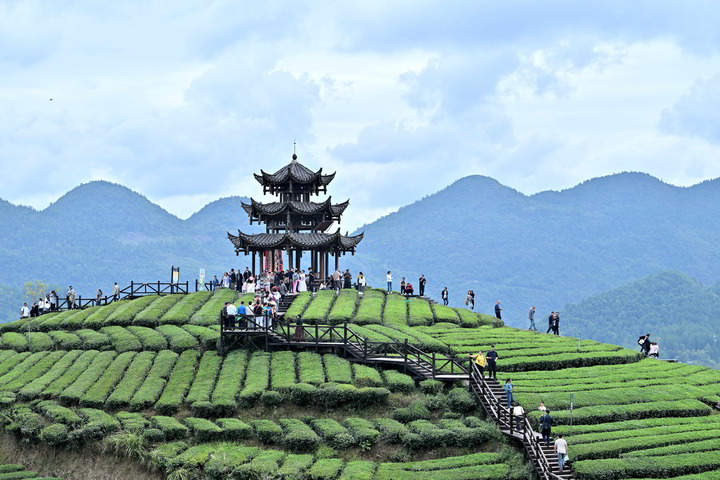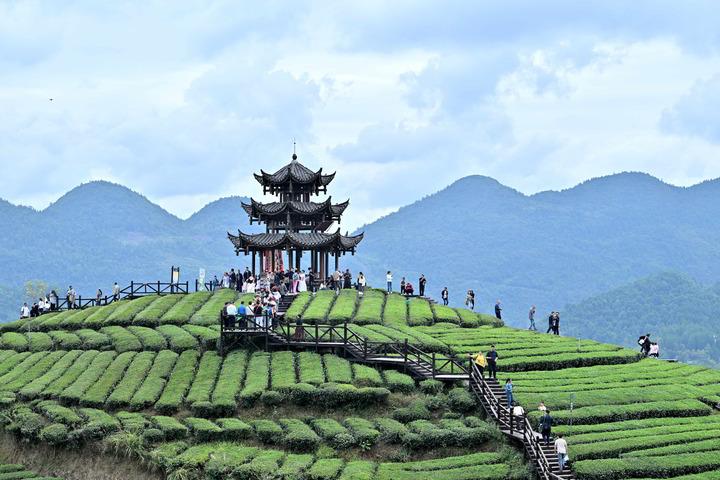BEIJING, Oct. 17 (Xinhua) -- Data for recent National Day holiday shows a relatively stable hotel booking, keeping with previous trend of "booking up, price down" during the summer vacation and the Mid-Autumn Festival: hotel booking at home and abroad both surged significantly for the holiday, while prices failed to catch up.
Tourists now show strong awareness of "cost effectiveness" in hotel consumption, experts say, who also observed increasing demand for high-quality hotels for county-level destinations.
The end of the National Day holiday heralded the advent of traditional idle season of the hotel sector. How hotels could stay in the game against rational consumption through ways such as exploring lower-tier cities grips market attention.

Tourists go sightseeing at a tea-themed scenic area in Xuanen County of Enshi Tujia and Miao Autonomous Prefecture, central China's Hubei Province, Oct. 2, 2024. (Photo by Chen Xukai/Xinhua)
-- The "booking up, price down" phenomenon
The Golden Week saw a craze for tourism consumption with booking volume and occupancy rate of most hotels seeing big year-on-year increase. According to the 2024 National Day holiday travel report released by Fliggy, booking volumes of domestic high-star hotels, route travels and car rentals all had significant growth year on year on a comparable basis. Following strong rebound last year, outbound tourism soared further, with relevant booking hiking by over 50 percent year on year, in which the booking of international hotels recovering to about 120 percent of that in 2019.
Looking into hotel brands, figures from Huazhu Group show that during this year's National Day holiday, the group received over 8.1 million people in total, 1.2 times compared with a year ago. The occupancy rate of its high grade brand MAXX had a year-on-year increase of 15 percentage points while that of brand Steigenberger Icons rose by 11 percentage points.
Nevertheless, hotel prices did not synchronize with such booking rise, but dropped down slightly compared with a year ago. It is estimated by Fliggy that the average domestic air ticket price and hotel price declined by about 13 percent and 6 percent year on year, while the prices of international air tickets and hotels fell by approximately 19 percent and 3 percent year on year.
Instead of gaining higher profit margin in the peak season, the hotel sector is going against the tradition of "big rise in price in every holiday", which is mainly caused by a faster increase of hotel supply, more competition, and consumers' preference of shorter vocation and higher cost effectiveness, experts say.
Mao Lin, an analyst from Ctrip Research Institute, said that the supply chains of air flights and hotels have kept recovering. In the first half of this year, more than 23,000 hotels were newly opened in China, providing over 1 million new rooms, while on the demand side, tourists are turning to a casual and relaxing "slow travel".
Qunar Big Data Research Institute once explained that consumers are becoming more sensitive to hotel prices while less tolerant to price hike in holidays. As the supply side keeps expanding, the market may confront intensive competition, and the phenomenon of "booking up, price down" is difficult to change in short run.
-- The trending county travel
Another highlight of hotel consumption in the past long holiday is the hot "county travel", resulting in a prominent rise of the occupancy rate of high-star hotels in counties.
China's cultural tourism is presently evolving towards higher quality and customization, where counties are more favored by consumers for their distinctive natural scenery, rich cultural heritage and lower cost. Survey shows that residents of the first- and second-tier cities are becoming the main sources of county travel, leading to a larger demand for hotels with better accommodation conditions. A Ctrip's consumption report points out that county travel is a new highlight of holiday tourism, and the hotel bookings in nearly 100 Chinese counties had a year-on-year increase of over 50 percent, higher than that of the whole sector.
Data on Qunar shows that during the Golden Week, domestic county destinations with high hotel booking growth include Yi County in Anhui, Gongyi in Henan, Ulan Butung in Inner Mongolia, Taizhou and Lishui in Zhejiang, Yubeng and Diqing in Yunnan, Diebu in Gansu, Benxi in Liaoning, Qiandongnan in Guizhou, among others. Most of these places are ideal for enjoying a beautiful autumn, and are also less crowded compared with traditional hot travel destinations. Ctrip also shows that the Xiaoxitian, a scenic spot in Linfen of north China's Shanxi Province, quickly gained popularity due to the recent best-selling video game Black Myth: Wukong, with its popularity hiked about 20 times compared with a year ago during the holiday.
In addition to cost-effectiveness, the richness and quality of tourism remain crucial to tourists. The swelling demand for high-quality hotels with rational prices in counties has propelled more hotel groups move to cover lower-tier markets, especially those leading brands of budget hotels.
Jin Jiang Hotels has so far opened more than 2,800 hotels in cities and counties below third-tier level, with a total of 4,000 contractual hotels. In 2024, the group concentrated on its existing individual hotels, while deployed mid-range backbone brands in the counties.
Deploying key brands such as Hanting, Ji Hotel and Orange, Huazhu Group has enhanced its penetration into lower-tier markets. Huazhu plans to newly open approximately 1,800 hotels in 2024, most of which are in lower-tier markets, and proposes an ambition of "Huazhu in every county" by 2030.
It is noted that well-established international luxury hotel groups such as Marriott, Hilton and InterContinental also join the county-level competition, laying eyes on lower-tier markets.
-- The changing arena for hotel competition
After scale competition and price competition in recent years for the hotel industry, market players are shifting their focus to such two paths as penetrating lower-tier markets and targeting mid- and high-end arenas. Of the two, more hotel brands choose to seek growth in lower-tier markets.
Domestic hotel sector is transitioning from a scale-oriented approach to a quality-oriented approach, according to Shi Chenning, board secretary with SSAW Hotels & Resorts, noting that leading enterprises would enjoy the benefits of market restructuring, and their outlet chain rate is expected to rise and reach about 45 percent by the end of 2024. Integration of the existing market will be an important part for development, and hotel groups are expected to adjusting their brand development models in their existing market.
Experts note that currently most hotels are harnessing competitiveness through upgrading product quality and penetrating into lower-tier cities. Huazhu Group, for example, has about 41 percent of in-service hotels located in markets of the third-tier cities or below, while 54 percent of the ready-to-launch hotels are deployed in these markets.
SSAW Hotels & Resorts noted that the group attached great importance to the potentials of the second- and third-tier cities such as Yangzhou and Foshan. Every single hotel of the group currently owns 200 rooms on average in the regions along the Beijing-Hangzhou Grand Canal, southwest China region and the Pearl River Delta, it noted.
With the tourism market returning to a rational consumption cycle, hotel groups should readjust their price and product strategies, suggested Guo Derong, chief analyst of Meadin Academy. Priority should be given to occupancy rate, keep price transparent and maintain a consistent brand image, Guo noted. Furthermore, hotels could try to provide more value-added services such as travel route planning, parent-child activities, so as to partnering with other sectors for profits and stage higher value for money for consumers, Guo said. (Edited by Niu Huizhe with Xinhua Silk Road, niuhuizhe@xinhua.org)




 A single purchase
A single purchase









